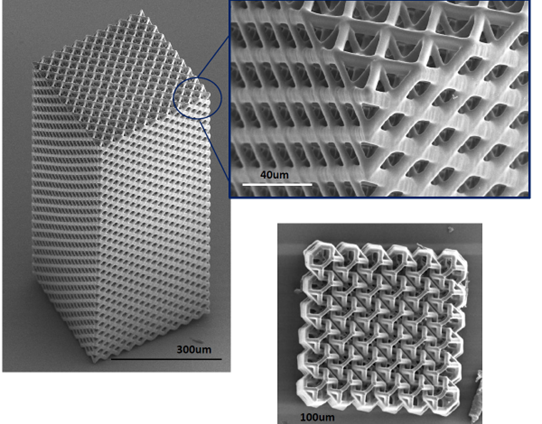Radical photoresists are commonly utilized in two-photon polymerization (TPP); however, cationic photoresists have also garnered significant interest. The commercially available epoxy-based SU-8 serves as a prototypical cationic photoresist. The parts of the SU-8 photoresist that are exposed to ultraviolet (UV) light becomes cross-linked while parts that are not UV exposed remain soluble. The resolution achievable with SU-8 in two-photon exposure is generally inferior in comparison to more advanced radical systems due to acid diffusion and the inability for oxygen to quench living cationic polymerization. To prepare for printing, SU-8 must be spin-casted onto a substrate,which limits the height of the printed part to a few microns. To advance cationic photoresist capabilities within TPP, a liquid resist is needed in order to print larger structures with fine resolution.
LLNL researchers have developed a liquid two-photon polymerization (TPP) epoxy based resin formulation capable of flowing under low load, which enables tall, centimeter-scale parts to be built using conventional TPP objectives with high working distance lenses. The unique photo-initiator chemistry helps to spatially control the extent of polymerization in the liquid resin improving print resolution and making it possible for cationic polymerization to be realized in TPP systems.
Compared to solid cationic resins, like SU-8 or the positive-tone resins which may not exhibit issues of over-polymerization, the described formulation requires an inhibitor and specific starting monomer viscosity to minimize acid diffusion and terminate the process to producing a well-controlled printed structure.
Related LLNL technologies:
Refractive index matched resins for Two-Photon Lithography
Optically clear photo-polymerization resists for additive manufacturing of radio-opaque parts
Parallel Two-photon Polymerization for Scalable Submicron Additive Manufacturing
Dual-Wavelength, Two-Photon Printing for High Resolution, Multi-Material 3D Structure Manufacturing
Image Caption: Printable LLNL resin for TPP using higher viscosity formulation
- Epoxy based, all liquid, negative tone resin formulation capable of flowing under low load.
- Capable of printing centimeter scale parts using conventional TPP objectives with high working distance lenses.
- Able to achieve all liquid, optically transparent formulation which can result in high resolution, smooth surface 3D printed structures.
- Provide an opportunity to enable multi-wavelength TPP capabilities since cationic polymerizations are orthogonal to free radical acrylate polymerizations.
This invention can enable the fabrication of 3D structures with small feature sizes and large sample dimensions that could be used for
- battery, fuel cell, or electrolyzer electrodes
- photonic or phononic crystals
- mechanical metamaterials, microelectromechanical systems (MEMS)
- integrated circuit chips
- quantum information processors
- microfluidic devices.
Current stage of technology development:
TRL ☐ 0-2 ☒ 3-5 ☐ 5-9
LLNL has filed for patent protection on this invention.


